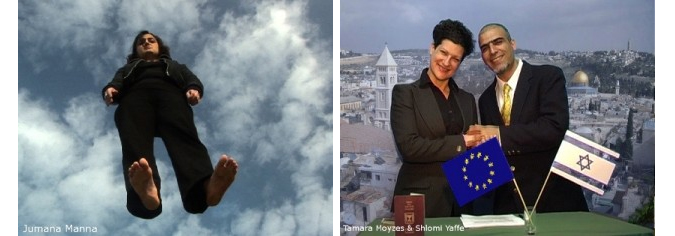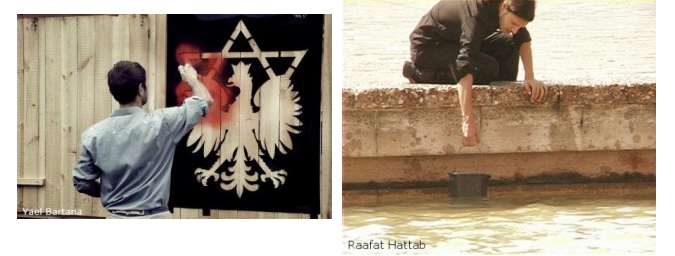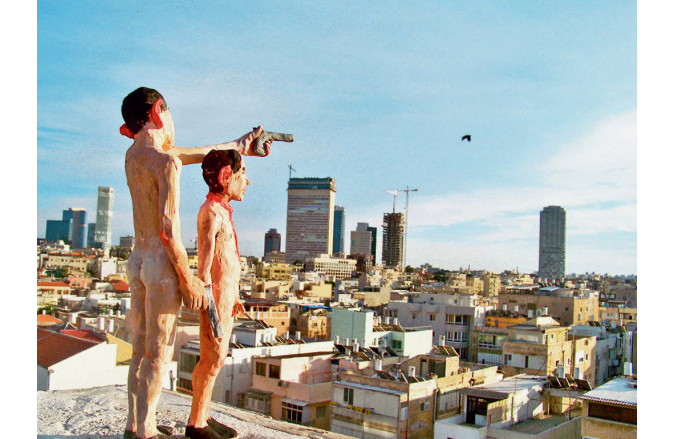I like DOX. It’s clearly trying to do something different to other galleries in Prague, host interesting and regularly changing exhibitions, and has cottoned on to the fact that all museums should have a decent shop.
The opening of DOX’s new exhibition Middle East Europe on Wednesday evening was full to the brim. This was a joyous contrast to many of my previous visits, which have seen staff outnumber visitors to an embarrassing and undeserved degree.
This new exhibition presents the contemporary and conceptual work of a number of European artists responding to the Middle Eastern conflict and considers the historical connections between continental Europe and the Middle East, contrasting anti-Semitism with Islamophobia.
At the same time, Middle East Europe considers the impact of modern media on wars and ethnic conflicts, focusing on Arab-Israeli tension. Do images of a foreign conflict inform a wide audience or do they deform the substance of the crisis? The most poignant example of a work seeking to answer this question this was Christopher Draegar’s video reconstruction of Operation Sunrise – the bungled German rescue attempt at the 1972 Munich Massacre, in which Palestinian terrorists kidnapped and eventually murdered eleven members of the Israeli Olympic team. Draegar’s video recalls how camera crews filmed the actions of German police and broadcast the images live on television, thus allowing the armed kidnappers and their hostages to watch the police preparations. Interesting, yet even thirty years after the event, barely believable. It made me recall the live footage of the September 11 terrorist attack in New York. Who having seen that live, could ever forget it?

But is a film reconstruction of real life events (albeit one accompanied by a mock-up of the bloody dorm room where at least one of the Israeli Olympiads was murdered) art? Is it important? The film is interesting historically, but does not seem to add significant dimensions to the events themselves.
The exhibition’s press release tells us: “Many artists find the roots of today’s [Middle East] problem in European anti-Semitism”. Fine, although this is not a terrifically original interpretation – akin to what many high school essays on “The causes of the current Arab-Israeli conflict” will also suggest. Certain installations provide a fresh perspective on this though, including Yael Bartana’s (fictional) film about Polish Jews returning from Israel to Poland.
This is an eerie and moving piece. A montage shows the establishment of a new kibbutz and returnees commencing a fresh life in Poland: members learning Polish and women planting flowers outside their make-shift wooden huts. All too quickly, though, a watch tower is erected and the settlement is covered with barbed wire, grotesquely similar to a concentration camp or the modern guarded settlements in the West Bank.

Some of the installations consider the dissonance between the high expectations of the ‘ideal’ State of Israel in Jewish-European thought and the unfortunate, depressing reality. Volker März’s mini-exhibition within the exhibition – Kafka in Israel – is an absurd mixed-media collection of this German artist’s extensive work.

Kafka in Israel by German artist Wolfram P. Kastner
März’s work is constructed on the imaginary premise that Kafka did not die from tuberculosis in 1924, but actually travelled to the Middle East with his monkey-friend as a companion. He died at a grand old age and went to heaven (which is a place where you have to tolerate one hundred versions of yourself – can you imagine?) until he was granted a reprieve and allowed to return to earth, to Israel. Due to an unfortunate mix-up Kafka actually landed in modern day Palestine, where he has been trying to cross to Israel ever since, all the time writing letters to various government officials.
Got it? No? Throw into the mix dozens of small but vividly painted figurines of Kafka, lots of frog maquettes and some red-eared donkeys and you’re nearly there. In the notes I made during the opening night I scribbled “A mixture of genius and utter nonsense”. I have reconsidered this since and will now settle for “Weird but strangely compelling, and very colourful.”
I heard the mutterings of a number of visitors complain that the exhibition did not offer much in the way of ‘art’. I agree that there is not much in Middle East Europe that will make a viewer think “gosh, I wish I could paint like that”. But this misses the point. This exhibition is highly conceptual and politicised, and thoroughly interesting. American artist Sol LeWitt provided a definition of conceptual art, suggesting “In conceptual art the idea or concept is the most important aspect of the work. When an artist uses a conceptual form of art, it means that all of the planning and decisions are made beforehand and the execution is a perfunctory affair. The idea becomes a machine that makes the art.” Middle East Europe is very, very, conceptual.
Showing until 20 April 2012 at DOX – Centre for Contemporary Art, Poupětova 1, Praha 7
Mon 10.00 – 18.00
Tue closed
Wed–Fri 11.00 – 19.00
Sat–Sun 10.00 – 18.00
What else is on in Prague?
The chillier months of January and February are a good time to explore Prague’s galleries and museums, and there’s a lot to see. These four particularly stand out:
David LaChapelleat Galerie Rudolfinum
This is a unique retrospective exhibition of the work of one of America’s foremost modern photographers David LaChapelle, including an overview of the most important periods and milestones of his work over the years. Shocking and witty in equal measure, I loved this. Ends 26 February 2012.
Tauromaquia – Face to face with the bull at Obecní dům
What a treat to have the works of artists including Picasso, Goya, and Dalí, Czech Filla and Čapek and modern Botero in one place! The exhibition’s controversial theme is the bullfight, which has been compellingly explored by each of the artists. Ends 9 April 2012.
Finalists of the 5th 333 Contest for Young Artists at Národní galerie (Veletržní Palace)
A chance to see some young Czech and Slovak artistic talent. The annual 333 Contest is a competition for young Czech and Slovak artists who may submit artworks in any genre or medium created in the last three years. The work of 11 finalists is exhibited at Veletržní Palace until 9 April 2012.
Aleš Veselý installations at DOX
Also at DOX, Czech sculptor Aleš Veselý shows three current pieces: You and I and Those Who Are No More, Entrance into Code and Narrow Slot. Large scale, metal constructions on a monumental scale are bound to impress. Until 31 March.
Don’t forget to pick up your ArtMap to keep up to date with contemporary art exhibitions in Prague galleries.
***
Helen Ford is a creator of CzechingIn, a blog about an English lady in
Prague. She writes for Expats.cz on topics such as theatre, art, and recently also tea houses and cafes.
Related articles












 Reading time: 5 minutes
Reading time: 5 minutes 



























